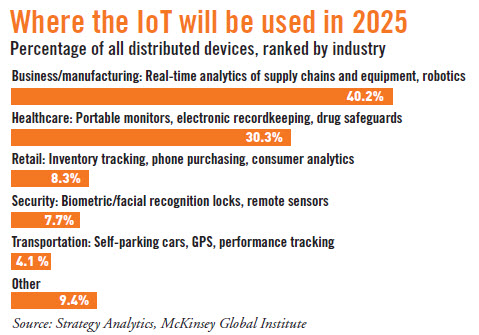IoT & Healthcare Facilities Data Management
[glossary_exclude]According to IDC, the IoT market will reach almost $750 billion this year. A major problem that the IoT brings is the rapid accumulation of large amounts of data. The adoption of IoT technology is resulting in previously unimaginable amounts of data. According to Help Net Security, in 2025 there will be 41.6 billion IoT devices on the internet generating 79.4 zettabytes of data. This represents a real challenge for healthcare facilities managers who find themselves having to manage more and more IoT-enabled smart buildings and the equipment within them.
Traditionally, the role of facilities manager dealt with physical infrastructure and mechanical devices. Now, commercial buildings are outfitted with equipment that generates significant levels of data such as electrical usage, temperature sensors, air flow volumes, and water flow measurements. Specifically, healthcare facilities have implemented IoT technology to ensure the comfort of their patients. Going forward, the facilities manager will have to work with the IT department to develop a facilities data analytics strategy to ensure that the IoT datasets do not become unmanageable.
In order to prepare for the coming onslaught of IoT data, the facilitates team should address this task first: Prepare the data infrastructure. Many IoT devices collect more information than is necessary. It is critical to develop a data plan focused on organizational goals such as reduced energy usage or enhanced customer experience via optimized lighting and temperature control. This can be accomplished by identifying the most relevant and valuable data, determining the sample rate, and then calculating the amount of storage space necessary for a day, a week, a month, and then a year. It is important to identify both short-term and long-term storage requirements. For example, it may make sense to keep daily data for 30 days and then covert the values into monthly averages that can be stored as a single record, replacing the multitude of daily entries.
The next priority is Data Security. The networked connectivity of devices brings with it significant security challenges. The Target Data breach started with the infiltration of their air conditioning system. It turns out that in many stores, the Point of Sale (POS) devices were connected to the same flat network as the A/C systems. The facilities team must coordinate their IoT usage with the CISO to ensure that facilities network is safe and segmented from other corporate network functions. Healthcare organizations must address the overlapping security roles that exist between IoT devices that monitor bio-metric data and IoT devices that monitor environmental data within the rooms used to provide patient care.
The final step is contingency planning. What happens when the smart meters stop talking? Is it possible to operate the building safely or does it need to be evacuated? Are the computers used to monitor the IoT sensors running current operating systems or are they stuck on Windows 95? Are the computers that manage the control systems backed-up on a regular basis? How long will it take to restore them in the event of a computer failure?
The Internet of Things (IoT) has brought several new dimensions to the Facilities Manager’s job description. Forward thinking companies will invest in their future by ensuring these individuals have the skills and training necessary to do their job well.[/glossary_exclude]
recent posts
You may already have a formal Data Governance program in […]

